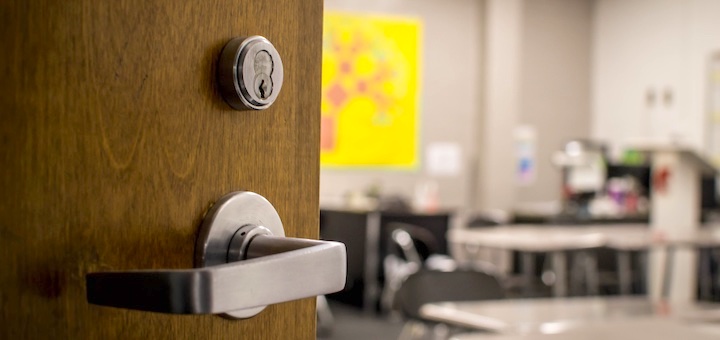Why I’m Keeping My Classroom Door Open
A MiddleWeb Blog
 “Your door should be locked and closed at all times,” the security briefing said, two years ago.
“Your door should be locked and closed at all times,” the security briefing said, two years ago.
“But no one does this, Ms. Strasser,” my kids tell me for the umpteenth time, knocking to come in from a drink or their locker.
“Then they’re doing it wrong,” I answer cheerfully – remembering the lockdown we had in September, where our entire faculty meeting hid behind the curtain of our auditorium and watched a SWAT team with automatic weapons march through us, seated on the floor, to secure the room. More than one of us were in tears.
But lately I’ve been thinking that maybe it’s more important, even than security, to leave my classroom door open.
This is a new way of thinking for me. I have a strong prepper/hiker/Boy Scout streak, and as the dangers of teaching have increased over my career, I have responded accordingly.
I keep my keys, wallet, and phone on my body at all times. I can’t risk having them away from me if we lock down. I consider carrying a stop-bleeding kit in my traveling teacher backpack. I don’t wear heels anymore – I can’t run in them. And, as I have been told, I keep the door locked and closed at all times.
Or have kept, I should say. I have noticed that there is a tangible impact to keeping the classroom door closed on the regular. I am isolated, physically and socially. I don’t wave at people passing by from my desk as I write email. I’m far less inclined to wander into the hallway to say hello to students and teachers, or investigate fun (or not fun) noises and conversations I hear.
The Cost of Closing the Door
I think often of the teacher aphorism regarding surviving the vagaries of school administration: “I just close the door and teach.” This may protect you temporarily from overeager vice principals, but what is the cost?
There is a cost on the other side of the door as well. Students notice when your door is closed or open: the former is a barrier, while the latter is an invitation. They are more likely to drop by intentionally – or wander in unintentionally, like the human puppies they are – if a door is not standing in their way.
Middle school students are also spooked easily, and even the small act of opening a door might be too much scrutiny and uncertainty for their developing social selves to handle. I have had students refuse to get copies printed in another room because the door is closed.
Weighing the Risk
There is also a final reason to keep the door open, one I had not realized until I started doing it: defiance. I do keep the door in locked mode – I can’t quite get over the nightmare of fiddling with my keys during an emergency. But leaving it standing open, ready to lock with a push, feels braver than I had anticipated.
It feels like a risk – a small one, but a risk nonetheless. Most important, it feels like a message to those who would dare to harm innocent people in a school. My students might say: “Come at me, bro.” I might say: “I will not teach in fear.”































I like this teacher’s attitude. When I was teaching, all the teachers on our hall kept their doors open, and like she said, but locked. We also had a large number of coaches teaching in our halls. As a result, the “hothead” students knew not to mess around in the hall. It also allowed any of the administration to poke their head in and say hi.